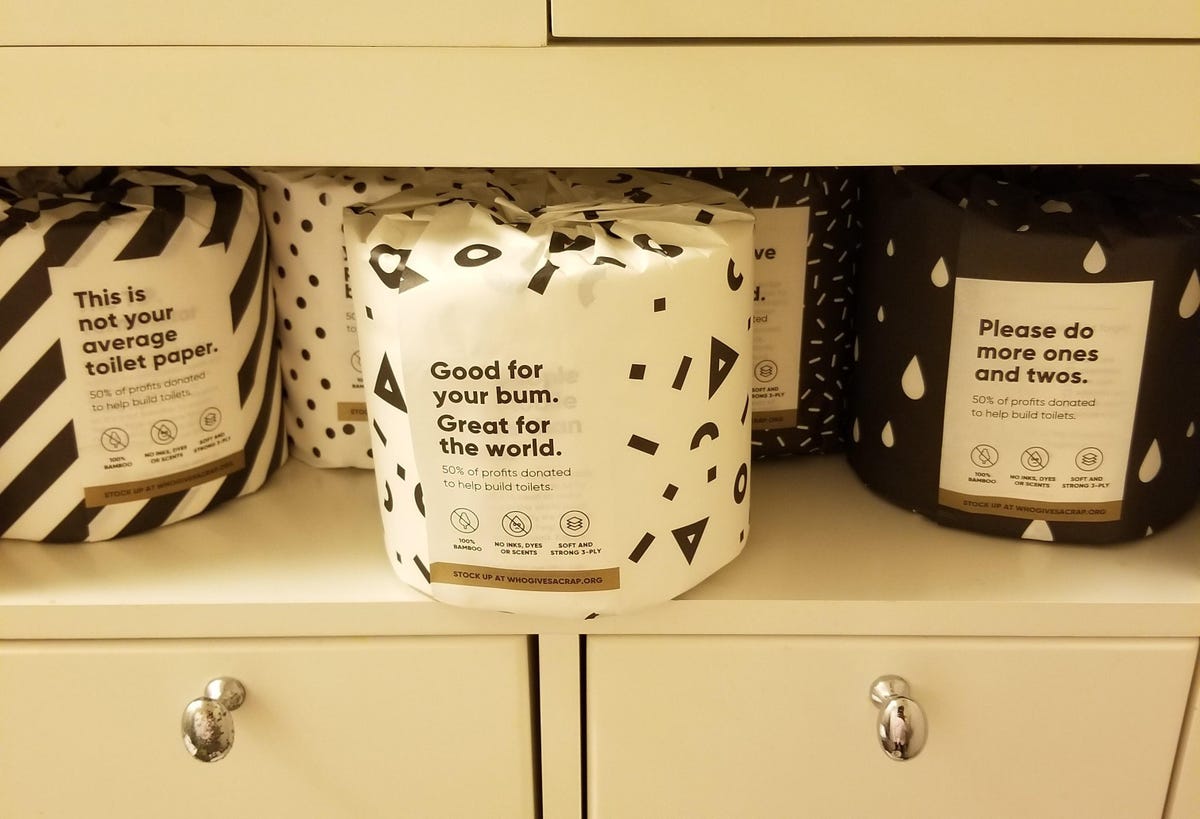
Who Gives A Crap product in a private home
Large consumer product companies have been successful because they deliver great products that function well or taste great at attractive prices that almost everyone can afford. But over the last several years, consumers have indicated they want products that deliver on personal values. Two concepts keep on trending: sustainability and wellness.
Big consumer product companies have been challenged to deliver on those attributes and small startups have taken advantage. The question for those startups is: are these long-term trends and if so, how big can these young companies get? If they remain niche businesses, they will also fail to achieve their goals of impacting sustainability and wellness in society. Which leads to the question: What does a company have to do to focus on values and still become very big?
Successful companies focused on values do three things that are very hard:
- They don’t sell on price. They almost never discount and are almost never the cheapest.
- Their consumers tell their friends personally or on social media which gives them marketing lift they don’t pay for.
- The business is key to their belief system. This is personal; leadership and management are motivated for social reasons, not just financially.
None of the companies that do these three things have yet achieved the scale of Unilever, Procter & Gamble, Coca-Cola and other large consumer product companies. Will it ever happen? I recently attended Retail X, trade show that bills itself as The Digital Future of Retail, and I spoke there with a number of CEOs of these successful companies.
Cost Efficiency
Even companies that don’t sell based on price must have a relentless focus on low costs is imperative or risk being undercut by competition. Phillip Raub of Model No., a sustainable furniture company that uses 3D printing and only makes products to order, says their strategy makes them efficient. By having no extra inventory to mark down, Model No. maintains profitability, avoiding price reductions on unsold inventory. Because their furniture is so durable, Raub also believes that there’s an opportunity to buy its furniture back from customers and resell in a secondary market, attracting consumers who could only afford resold products.
MORE FOR YOU
Reham Fagiri, the founder of sustainability-focused furniture resale site AptDeco, agrees. AptDeco enables consumers who can’t afford new, expensive furniture to buy it in the resale market and is working with large retailers to help them develop a resale component to their businesses. AptDeco is building a centralized marketplace to make resold furniture from all major brands available to consumers.
Some sustainable and wellness companies say they are already at par with their larger competitors on costs. Andrea Lisbona is the Founder & CEO of Touchland, a hand sanitizer company with popular fragrances and packaging that looks more like an iPhone than anything else. She says that although the ticket price of their product is higher, consumers get a lot more uses out of it than the gels made by the big players. Danny Alexander, Co-Founder of toilet paper company Who Gives A Crap (sic) talks about “cost per wipe” explaining they maintain costs by spending far less on marketing and promotion than the competition.
Not everyone agrees that efficiency is the goal. Lindsay McCormick is the CEO and Founder of a company called Bite that eliminates the plastics and containers in normal dental care routines by selling products on subscription in compostable containers. “I don’t see myself wanting to be Crest or Colgate,” she told me. “I want to make the most sustainable products, paying fair wages … [and proving] this is viable.” To expand, Bite intends to expand horizontally into other bathroom and grooming products.
McCormick may be on to something that makes her business more successful. According to a special Edelman Trust Barometer report first reported by Axios, more than half (61%) of employees say they would evaluate an employer based on its stance on social issues or employees’ ability to express their beliefs. McCormick’s stridency about her values may make it easier for her company to get the best people.
And still there are enormous challenges to overcome. Jomaree Pinkard, CEO & Co-Founder of Hella Cocktail whose hero product is a premium bitters and soda beverage, says that increasing carbon-efficiency is hard because the existing supply chain “has a chokehold on what’s possible.” He cites the aluminum containers that Hella uses for its products. Although aluminum can be recycled, taking it out of the ground is environmentally damaging. But the big companies use so much of it it’s inexpensive and Hella can’t compete if it switches to more environmentally friendly containers.
Marketing
Successful companies can’t spend unlimited amounts on marketing. I have seen the financials of hundreds of private companies and found that profit, after deducting the cost of goods and the entire marketing budget, needs to be 40% of net revenue or more. If it isn’t, it’s almost impossible to get to meaningful profitability. But the cost of marketing online is rising and getting more complex. To be effective companies need new ways of communicating without resorting to incessant paid messaging and advertising.
The picture of Who Gives A Crap products at the top was taken by me in the bathroom of a private home I visited. The homeowners were proudly displaying their commitment to a sustainable but cheeky brand. When consumers tell their friends about products, it turbocharges a company’s marketing spend. Without help from consumers using word-of-mouth and social media posts, it’s usually impossible for a brand to reach the profitability it needs. Lisbona of Touchland told me, “we want to unlock the ability of people to turn their friends into customers.”
Terri Rockovich, Co-Founder and CEO of dog food brand Jinx, uses the unique measure of its dog food digestibility to compete and avoid message clutter. Jinx leverages objective performance metrics to motivate consumers to maintain their delivery subscriptions and get shelf space in some of the largest retailers in the world, including Target and others to be announced.
Pinkard of Hella Cocktail told me the company preserved capital by launching in places you wouldn’t expect. Because they are focused on an “elevated food and beverage experience,” they initially sold in West Elm, Sur la Table and other home retailers where consumers see Hella products and no competitive distractions. Lisbona of hand sanitizer Touchland said that even before the pandemic their products were sold in Ulta, Urban Outfitters, Nordstrom, Bloomingdale’s and Revolve, almost none of whom sold hand sanitizer before Touchland. Having a clear message in a unique and target-rich environment is a cost-effective way companies communicate without noise and ever-rising costs.
The Mission
Every expert I talk to says that sustainability and wellness are not temporary blips but long-term trends and it’s clear that being mission-based is driving success. McCormick of Bite reports that the business is growing at 200% per year; Bite has not raised outside capital which means that the company is financing its growth through profits. But the question of how big a mission-driven business can get is still open. The largest consumer companies have usually acquired many different brands and we are starting to see acquisitions of the smaller upstarts. No one knows what the effect of combining multiple mission-driven businesses into one corporate structure will be on culture and authenticity.
The answer to the question about whether these companies can get very big is: it’s too early to tell. A number of them will fail because their business model isn’t right. But for those that can find the narrow path to economic success, none have yet proven that they can be massive businesses. Over time, we may see mission-driven businesses divert from their paths in order to grow and we may see the largest consumer product businesses add more meaningful personal values to their strategies. For now, we are left to wonder whether sustainability, wellness, or any purpose-driven corporate mission can get to the scale they need to be truly impactful in the world. It will take more than reaching high-income, high-education households and we’re going to have to wait for the answer. Time will tell.







